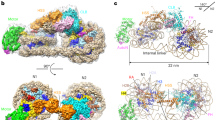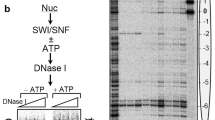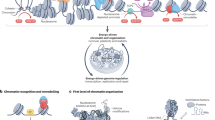Abstract
Repressive chromatin structures need to be unravelled to allow DNA-binding proteins access to their target sequences. This de-repression constitutes an important point at which transcription and presumably other nuclear processes can be regulated1,2. Energy-consuming enzyme complexes that facilitate the interaction of transcription factors with chromatin by modifying nucleosome structure are involved in this regulation3,4,5. One such factor, nucleosome-remodelling factor (NURF), has been isolated from Drosophila embryo extracts4,6,7. We have now identified a chromatin-accessibility complex (CHRAC) which uses energy to increase the general accessibility of DNA in chromatin. However, unlike other known chromatin remodelling factors, CHRAC can also function during chromatin assembly: it uses ATP to convert irregular chromatin into a regular array of nucleosomes with even spacing. CHRAC combines enzymes that modulate nucleosome structure and DNA topology. Using mass spectrometry, we identified two of the five CHRAC subunits as the ATPase ISWI, which is also part of NURF6,8, and topoisomerase II. The presence of ISWI in different contexts suggests that chromatin remodelling machines have a modular nature and that ISWI has a central role in different chromatin remodelling reactions.
This is a preview of subscription content, access via your institution
Access options
Subscribe to this journal
Receive 51 print issues and online access
$199.00 per year
only $3.90 per issue
Buy this article
- Purchase on Springer Link
- Instant access to full article PDF
Prices may be subject to local taxes which are calculated during checkout






Similar content being viewed by others
References
Kingston, R., Bunker, C. & Imbalzano, A. N. Repression and activation by multiprotein complexes that alter chromatin structure. Genes Dev. 10, 905–920 (1996).
Felsenfeld, G. Chromatin unfolds. Cell 86, 13–19 (1996).
Peterson, C. L. & Tamkun, J. W. The SWI–SNF complex: a chromatin remodelling machine? Trends Biochem. Sci. 20, 143–146 (1995).
Tsukiyama, T. & Wu, C. Purification and properties of an ATP-dependent nucleosome remodelling factor. Cell 83, 1011–1020 (1995).
Cairns, B. R.et al. RSC, an essential, abundant chromatin-remodelling complex. Cell 87, 1249–1260 (1996).
Tsukiyama, T., Daniel, C., Tamkun, J. & Wu, C. ISWI, a member of the SWI2/SNF2 ATPase family, encodes the 140 kD subunit of the nucleosome remodelling factor. Cell 83, 1021–1026 (1995).
Tsukiyama, T., Becker, P. B. & Wu, C. ATP-dependent nucleosome disruption at a heat-shock promoter mediated by binding of GAGA transcription factor. Nature 367, 525–532 (1994).
Elfring, L. K., Deuring, R., McCallum, C. M., Peterson, C. L. & Tamkun, J. W. Identification and characterization of Drosophila relatives of the yeast transcriptional activator SNF2/SWI2. Mol. Cell. Biol. 14, 2225–2234 (1994).
Becker, P. B. & Wu, C. Cell-free system for assembly of transcriptionally repressed chromatin from Drosophila embryos. Mol. Cell. Biol. 12, 2241–2249 (1992).
. Becker, P. B., Tsukiyama, T. & Wu, C. Chromatin assembly extracts from Drosophila embryos. Meth. Cell Biol. 44, 207–223 (1994).
Varga-Weisz, P. D., Blank, T. A. & Becker, P. B. Energy-dependent chromatin accessibility and nucleosome mobility in a cell-free system. EMBO J. 14, 2209–2216 (1995).
Wilm, M.et al. Femtomole sequencing of proteins from polyacrylamide gels by nano-electrospray mass spectrometry. Nature 379, 466–469 (1996).
Mann, M. & Wilm, M. Error-tolerant identification of peptides in sequence databases by peptide sequence tags. Analyt. Chem. 66, 4390–4399 (1994).
Berger, J. M., Gamblin, S. J., Harrison, S. C. & Wang, J. C. Structure and mechanism of DNA topoisomerase II. Nature 379, 225–232 (1996).
Wang, W. D.et al. Diversity and specialization of mammalian SWI/SNF complexes. Genes Dev. 10, 2117–2130 (1996).
Wang, J. C. DNA topoisomerases. Annu. Rev. Biochem. 65, 635–692 (1996).
Almouzni, G. & Méchali, M. Assembly of spaced chromatin. Involvement of ATP and DNA topoisomerase activity. EMBO J. 7, 4355–4365 (1988).
Walter, P. P., Owen-Hughes, T. A., Coté, J. & Workman, J. L. Stimulation of transcription factor binding and histone displacement by nucleosome assembly protein 1 and nucleoplasmin requires disruption of the histone octamer. Mol. Cell. Biol. 15, 6178–6187 (1995).
Chen, G. L.et al. Nonintercalative antitumor drugs interfere with the breakage-reunion reaction of mammalian DNA topoisomerase II. J. Biol. Chem. 259, 13560–13566 (1984).
Buchenau, P., Saumweber, H. & Arndt, J. D. Consequences of topoisomerase II inhibition in early embryogenesis of Drosophila revealed by in vivo confocal laser scanning microscopy. J. Cell Sci. 104, 1175–1185 (1993).
Poljak, L. & Käs, E. Resolving the role of topoisomerase II in chromatin structure and function. Trends Cell Biol. 5, 348–354 (1995).
Wartburton, P. E. & Earnshaw, W. C. Untangling the role of DNA topoisomerase II in mitotic chromosome structure and function. BioAssays 19, 97–99 (1997).
Earnshaw, W. C., Halligan, B., Cooke, C. A., Heck, M. M. & Liu, L. F. Topoisomerase II is a structural component of mitotic chromosome scaffolds. J. Cell Biol. 100, 1706–1715 (1985).
Gasser, S. M., Laroche, T., Falquet, J., Boy de la Tour, E. & Laemmli, U. K. Metaphase chromosome structure. Involvement of topoisomerase II. J. Mol. Biol. 188, 613–629 (1986).
Swedlow, J. R., Sedat, J. W. & Agard, D. A. Multiple chromosomal populations of topoisomerase II detected in vivo by time-lapse, three-dimensional wide-field microscopy. Cell 73, 97–108 (1993).
Sandaltzopoulos, R., Mitchelmore, C., Bonte, E., Wall, G. & Becker, P. B. Dual regulation of the Drosophila hsp26 promoter in vitro. Nucleic Acids Res. 23, 2479–2487 (1995).
Shevchenko, A., Wilm, M., Vorm, O. & Mann, M. Mass spectrometric sequencing of proteins from silver-stained polyacrylamide gels. Analyt. Chem. 68, 850–858 (1996).
Wilm, M. & Mann, M. Analytical properties of the nanoelectrospray ion source. Analyt. Chem. 68, 1–8 (1996).
Wall, G., Varga-Weisz, P. D., Sandaltzopoulos, R. & Becker, P. B. Chromatin remodelling by GAGA factor and heat shock factor at the hypersensitive Drosophila hsp26 promoter in vitro. EMBO J. 14, 1727–1736 (1995).
Acknowledgements
This research was supported by an EMBO fellowship to P.D.V. and by a grant for the DFG to P.B.B. We thank T. Tsukiyama and C. Wu for a generous gift of NURF fractions and ISWI antibodies, S. Beek and J. Tamkun for antibodies against ISWI, P. Fisher and D. Arndt-Jovin for antibodies against topo II; A. Shevchenko for technical help, H. Stunnenberg for important suggestions and discussions, T. Blank and C. Garcia-Jimenez for introduction to chromatography and P. Riedinger for artwork.
Author information
Authors and Affiliations
Corresponding author
Rights and permissions
About this article
Cite this article
Varga-Weisz, P., Wilm, M., Bonte, E. et al. Chromatin-remodelling factor CHRAC contains the ATPases ISWI and topoisomerase II. Nature 388, 598–602 (1997). https://doi.org/10.1038/41587
Received:
Accepted:
Issue Date:
DOI: https://doi.org/10.1038/41587
This article is cited by
-
Energy-driven genome regulation by ATP-dependent chromatin remodellers
Nature Reviews Molecular Cell Biology (2024)
-
Nucleosome density shapes kilobase-scale regulation by a mammalian chromatin remodeler
Nature Structural & Molecular Biology (2023)
-
Topoisomerase II is regulated by translationally controlled tumor protein for cell survival during organ growth in Drosophila
Cell Death & Disease (2021)
-
Ruler elements in chromatin remodelers set nucleosome array spacing and phasing
Nature Communications (2021)
-
Yeast chromatin remodeling complexes and their roles in transcription
Current Genetics (2020)
Comments
By submitting a comment you agree to abide by our Terms and Community Guidelines. If you find something abusive or that does not comply with our terms or guidelines please flag it as inappropriate.



